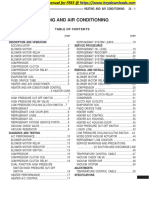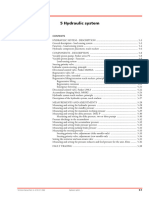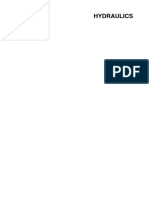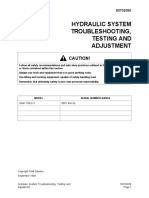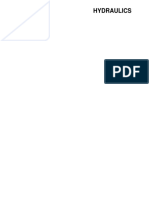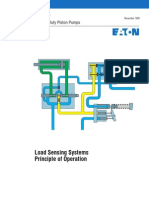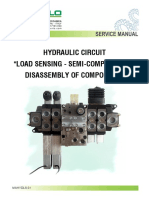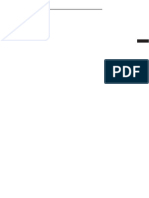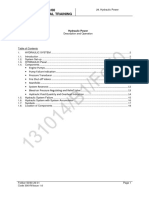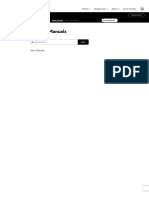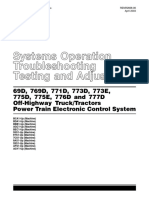Hydraulika
Hydraulika
Uploaded by
Robert Nie WiemCopyright:
Available Formats
Hydraulika
Hydraulika
Uploaded by
Robert Nie WiemCopyright
Available Formats
Share this document
Did you find this document useful?
Is this content inappropriate?
Copyright:
Available Formats
Hydraulika
Hydraulika
Uploaded by
Robert Nie WiemCopyright:
Available Formats
5 Hydraulic system
Technical manual Publ. no. 6193.034 0944
CONTENTS
HYDRAULIC SYSTEM - DESCRIPTION ............................................................. 5-3
General description - load sensing system ................................................................. 5-3
Function - Load-sensing system ................................................................................ 5-4
Hydraulic component placement, fork lift truck SMV 10-16 B. ............................... 5-6
COMPONENTS - DESCRIPTION ........................................................................ 5-8
Variable piston pump, Parker series P2 ..................................................................... 5-8
Variable piston pump - Function .............................................................................. 5-9
Steering priority valve ............................................................................................. 5-13
hydraulic system steering, principle ........................................................................ 5-14
Directional control valve, Parker L90LS ................................................................. 5-16
Directional control valve, Parker HV08 .................................................................. 5-18
Accumulator charging block, M0382 ..................................................................... 5-20
Hydraulic system fork lift truck SMV 10-16 B, principle ....................................... 5-22
Description of the hydraulic system, fork lift truck ................................................. 5-23
MEASUREMENTS AND ADJUSTMENTS ......................................................... 5-24
Measuring and setting the hydraulic pressure .......................................................... 5-24
Measuring and setting the standby pressure, one pump .......................................... 5-24
Measuring and setting the standby pressure, more than one pump ......................... 5-24
Measuring and setting the maximum working pressure .......................................... 5-25
Measuring and setting the delta pressure, Delta-P ................................................... 5-26
Pressure discharge in the accumulator ..................................................................... 5-28
Measuring and setting the accumulator pressure ..................................................... 5-28
Measuring and setting the brake pressure switch ..................................................... 5-28
Measuring and setting parking brake pressure ......................................................... 5-28
Measuring the steering pressure .............................................................................. 5-29
Setting the restrictor and non-return valve .............................................................. 5-31
FAULT TRACING ................................................................................................ 5-32
Technical manual Publ. no. 6193.034 0944 Hydraulic system 5-1
5-2 Hydraulic system Technical manual Publ. no. 6193.034 0944
Hydraulic system - Description
HYDRAULIC SYSTEM - DESCRIPTION
GENERAL DESCRIPTION - LOAD SENSING SYSTEM
In a load sensing hydraulic system the pump only supplies the flow
required for the functions on each occasion they are connected, i.e.
the pump’s output is not greater than the current load. The
hydraulic system in all SMV’s trucks is load sensing. The
advantages of a load-sensing system are:
• lower energy consumption.
• less heat development.
• greater precision and more flexible manoeuvring of the
machine.
• smaller losses and less wear to the hydraulic system.
• no flow in the system when it is not used.
• only the necessary flow when lifting or moving.
• no unnecessary overpressure when lifting small loads.
In a load-sensing system, the load the system is subjected to is
measured and this controls the output from the hydraulic pump;
the system remains in balance: light load - low output, heavy load -
high output.
The heart of the system is the variable piston pump. When the load
on the system changes, for example, when lifting, a signal provides
the pump with information about the change and a corresponding
change is made to the output.
Technical manual Publ. no. 6193.034 0944 Hydraulic system 5-3
Hydraulic system - Description
The diagram shows the principle of a load-sensing system. The
load signal (LS) which controls the pump, is taken from the
directional control valve.
FUNCTION - LOAD-SENSING SYSTEM
The truck driver controls the hydraulic functions using joysticks
that actuate the directional control valve. The system is
proportional, i.e. a small joystick movement gives a small
deflection on the directional control valve (little oil flow), and large
joystick movement gives a larger deflection on the valve (large oil
flow).
V0015
A LS When the directional control valve is closed the pump gives a low
basic pressure, which is known as standby pressure. When the
system is put to work, oil flows through the directional control
valve, from P to A, and a pressure drop arises. This is called DeltaP.
The standby pressure should be slightly higher than DeltaP. It is
important that the pump provides the correct standby pressure in
V0016 P T order for the system to work correctly.
When the joystick is in the neutral position, i.e. when no work is
being carried out, the load signal is 0. The output from the pump,
which corresponds to the standby pressure, is very low and with
that the output requirement from the diesel engine is also low.
V0017
5-4 Hydraulic system Technical manual Publ. no. 6193.034 0944
Hydraulic system - Description
Small joystick movement only requires a small flow, yet high
pressure. The load signal provides the pump with information, this
is then set to give the right output.
45
V0018
Both a large flow and high pressures are required in response to
large joystick movement. The load signal provides the pump with
information, this is then set to give maximum output.
45
V0019
Technical manual Publ. no. 6193.034 0944 Hydraulic system 5-5
Hydraulic system - Description
HYDRAULIC COMPONENT PLACEMENT, FORK LIFT
TRUCK SMV 10-16 B.
V0036
5-6 Hydraulic system Technical manual Publ. no. 6193.034 0944
Hydraulic system - Description
1. Steering cylinder
2. Variable piston pump, 105 cc
3. Gear pump, 23 cc
4. Accumulator
5. Steering orbitrol
6. Tilt cylinder
7. Lifting cylinder
8. Side shift cylinder
9. Directional control valve
10. Multi-disc brake
11. Parking brake
12. Steering priority valve
13. Accumulator charging block
14. Hydraulic tank
Technical manual Publ. no. 6193.034 0944 Hydraulic system 5-7
Components - description
COMPONENTS - DESCRIPTION
VARIABLE PISTON PUMP, PARKER SERIES P2
V0007
V0006
1. Input shaft 7. Servo piston
2. Adjuster screw, Delta P 8. Swashplate
3. Adjuster screw, Pmax 9. Pump housing
4. Adjuster screw, displacement 10. Piston
5. Outlet 11. Barrel
6. Inlet
V0008
5-8 Hydraulic system Technical manual Publ. no. 6193.034 0944
Components - description
VARIABLE PISTON PUMP - FUNCTION
The input shaft rotates and drives the barrel and pistons. Oil is
drawn into the cylinders on the inlet side and is pressed out of the
cylinders on the outlet side. The volumes (V1) and (V2) are
determined by the angle of the swashplate (A) and the difference
between (V1) and (V2) is the volume of oil (displacement) the
pump gives per revolution. When the load signal is zero or at full
output from the pump, the swashplate (A) is tilted to maximum.
The difference in volume on the inlet side (V1) and outlet side
(V2) is at its most and the pump supplies maximum oil flow.
V0024
When less oil is required, the angle (A) of the swashplate is
reduced. The difference between (V1) and (V2) drops and the
pump supplies a smaller quantity of oil.
V0025
With minimal oil requirement, the angle (A) of the swash-plate is
virtually 0 and the difference (V1-V2) is at its least and the pump
supplies a small oil flow.
V0026
Technical manual Publ. no. 6193.034 0944 Hydraulic system 5-9
Components - description
Load-sensing system
The diagram shows the system with the diesel engine switched off
where the pressure and flow are 0. When there is no pressure in the
system the pump’s spring-loaded actuator piston (1) is in the
position for maximum pump output. The line from the control
piston runs via the valve for maximum pressure (Pmax) and
standby pressure valve (DeltaP) directly to the hydraulic tank. It is
possible to adjust the pressure in both valves with the help of
adjuster screws.
When the diesel engine is started, the pump gives maximum
output for a short period until the standby pressure is reached.
Once the standby pressure has been reached, the valve (2) adjusts
the pump and maintains this at the set pressure irrespective of the
speed of the diesel engine.
5-10 Hydraulic system Technical manual Publ. no. 6193.034 0944
Components - description
When the system is put to work (via the joystick) the directional
control valve (3) changes position and the LS line is pressurised.
The valve (4) is reset and the pressure in the actuator piston (5)
drops. The pump output then increases until it corresponds with
the load on the system.
When the pump output corresponds to the load on the system, the
valve (6) is adjusted and maintains the pump at the right output.
Technical manual Publ. no. 6193.034 0944 Hydraulic system 5-11
Components - description
When the cylinder is moved to the end position, the pressure can
reach max. pressure.
The pressure in the load signal (LS) increases and the valve (4) is
reset. The pressure in the actuator piston (5) decreases and the
pump output increases.
When the pump output is equal to the set max. pressure for the
valve (7) its position changes. The pressure in the actuator piston
(8) increases and the pump output decreases. The pressure is
maintained until the cylinder moves or the directional valve is
switched.
5-12 Hydraulic system Technical manual Publ. no. 6193.034 0944
Components - description
STEERING PRIORITY VALVE
The steering priority valve is preset to give a controlled pressure of
180-200 bar.
1. Pressure regulator
2. Load sensor (LS), load signal from steering orbitrol
3. Excess flow (EF), to directional valve
4. Controlled flow (CF), to steering orbitrol
5. External pilot signal (PP)
6. From the piston pump (P)
1. Pressure regulator
Technical manual Publ. no. 6193.034 0944 Hydraulic system 5-13
Components - description
HYDRAULIC SYSTEM STEERING, PRINCIPLE
1. Steering cylinder
2. Steering orbitrol
3. Steering priority valve
4. Pressure regulator
5. Shuttle valve
6. Restrictor and non-return valve
7. Variable piston pump, 105 cc
8. Hydraulic tank
V0508
5-14 Hydraulic system Technical manual Publ. no. 6193.034 0944
Components - description
Oil is led from the variable piston pump (7) (105 cc) to the
steering priority valve (3). The task of the steering priority valve is
to always supply the steering system with oil ahead of the truck’s
other hydraulic functions.
When the diesel engine is started the pressure builds up to the
standby pressure.
P on the steering priority valve receives standby pressure from the
pump. The standby pressure is transferred to CF (controlled flow)
and further to the steering orbitrol.
Return pressure at the steering orbitrol is fed to PP (Pilot Pressure)
on the priority valve. The valve switches position so that the stanby
pressure is on EF (Extra Flow) to which the directional valve is
connected. A small. contracted oil flow is fed through the LS-line
via the steering orbitrol into the tank.
When the steering orbitrol is activated (when steering) the pressure
on (PP) drops and the priority valve switches position again and oil
flows from the pump via the priority valve (P to CF), the steering
orbitrol (P) to the steering cylinder.
The adjustable pressure regulator (4) opens at maximum steering
pressure (steering to end position).
Technical manual Publ. no. 6193.034 0944 Hydraulic system 5-15
Components - description
DIRECTIONAL CONTROL VALVE, PARKER L90LS
5-16 Hydraulic system Technical manual Publ. no. 6193.034 0944
Components - description
1. PS, pilot circuit for joysticks
2. TPB, tank connection for pilot circuit
3. B, hydraulic function
4. A, hydraulic function
5. Connections from control joysticks
6. Control for emergency lowering (fork-lift trucks)
7. P1, pump connection
8. T1, tank connection
9. Electrically controlled proportional valve
10. LS, load signal connection, copied
11. PX, pump pressure
12. PL, non-copied load signal
13. Valve for maximum pressure
14. Copy slide; Copies the load signal from hydraulic
function to the pump
15. Pressure limiter on load signal; Used for extra functions,
for example, joystick steering
16. Pressure regulator for pilot pressure
17. Shuttle: Gives priority to highest load signal
18. Compensator valve: Limits the highest permitted
pressure for the circuit
19. Non-return valve
20. Manoeuvre slide
Technical manual Publ. no. 6193.034 0944 Hydraulic system 5-17
Components - description
DIRECTIONAL CONTROL VALVE, PARKER HV08
3 6
10
A B
1 2 3
10 9 8 7 6 5 4
A 2 spool sections
B 1 spool section
5-18 Hydraulic system Technical manual Publ. no. 6193.034 0944
Components - description
1. Pressure balance point A-B port
2. P1, pump connection section slide
3. T2, tank connection
4. LSU, load signal connection
5. Load signal, drainage
6. Section slide
7. Plug copy slide
8. Copy slide
9. Non-return valve
10. P, pump connection
Technical manual Publ. no. 6193.034 0944 Hydraulic system 5-19
Components - description
ACCUMULATOR CHARGING BLOCK, M0382
5-20 Hydraulic system Technical manual Publ. no. 6193.034 0944
Components - description
1. Solenoid, parking brake The accumulator charging block receives oil from a gear pump. Oil
2. Pressure regulator, adjustable, parking brake is distributed in the block to the accumulator, service brake and
3. Manual valve for pressure discharge in the accumulator parking brake. In the event of engine failure these functions receive
4. Pressure limiting valve oil from the accumulator via the accumulator block.
5. Non-return valve
6. Restrictor valve The following components/functions are housed in the
7. Charge valve accumulator block:
8. Pressure regulator, adjustable, accumulator
• Solenoid (1) for parking brake. Electrically controlled valve to
activate the parking brake. When the valve is not activated, the
parking brake is employed.
• Adjustable pressure regulator (2) for the parking brake circuit.
Reduces the pressure from the accumulator to the parking brake
circuit.
• Valve (3) for pressure discharge. The accumulator is drained
manually using a hex key. Used BEFORE working on the
hydraulic system.
• Valve (4) for maximum pressure preset to 250 bar. Prevents
excess charging of the accumulator.
• Non-return (5) resp. restrictor valve (6) in the circuit between
the pump and the accumulator/service brake. The non-return
valve prevents the accumulator from being discharged when the
engine is switched off.
• Charge valve (7). Regulates the pressure to the accumulator
circuit. Controlled by the pressure regulator (8).
• Adjustable pressure regulator (8) for the accumulator. Measures
the pressure in the accumulator circuit and controls the valve
(7). Accumulator charging starts when the pressure is 20 %
below the set pressure.
Technical manual Publ. no. 6193.034 0944 Hydraulic system 5-21
Components - description
HYDRAULIC SYSTEM FORK LIFT TRUCK SMV 10-16 B,
PRINCIPLE
5-22 Hydraulic system Technical manual Publ. no. 6193.034 0944
Components - description
1. Hydraulic tank DESCRIPTION OF THE HYDRAULIC SYSTEM, FORK LIFT
2. Gear pump, 23 cc TRUCK
3. Variable piston pump, 105 cc
4. Restrictor and non-return valve A gear pump (2) (23 cc) supplies the accumulator charging block
5. Shuttle valve (13) with oil from the hydraulic tank (1). The pressure is
6. Steering priority valve distributed in the block to the accumulator (12), service brake (11)
7. Steering cylinder and the parking brake (9). Oil from the block also cools the multi-
8. Steering orbitrol disc brake (10) in the drive axle. The gear pump is seated in
9. Parking brake tandem on the variable piston pump (3) (Parker series P2, 105 cc).
10. Multi-disc brake Oil from the piston pump goes to the steering priority valve (6)
11. Service brake valve which distributes the oil to the steering orbitrol (8) and the
12. Accumulator directional control valve (16) (Parker L90). The priority valve
13. Accumulator charging block ensures that the steering is given priority over the truck’s other
14. Return filter functions. The load signal is led back from the steering orbitrol to
15. Hydraulic functions the priority valve and to the shuttle valve (5) where it is compared
16. Directional control valve, L90 to the load signal from the directional control valve. After the
17. Control joysticks shuttle valve, the load signal is led via a restrictor and non-return
valve (4) to the piston pump. The directional control valve is
controlled from the control joysticks in the cab and distributes oil
out to respective hydraulic functions (15). The return oil from the
functions runs via the directional control valve back to the
hydraulic tank where the return filter (14) is located.
A detailed description of the hydraulic components can be found
in the section “Components - description” on page 8.
Technical manual Publ. no. 6193.034 0944 Hydraulic system 5-23
Measurements and adjustments
MEASUREMENTS AND ADJUSTMENTS
MEASURING AND SETTING THE HYDRAULIC PRESSURE
Placement of the metering outlet and adjustment points differ
slightly on the different truck models. Illustrations show the
principle for respective measuring/setting.
The pressure values not stated in this publication can be found on
the machine card under group 70 “hydr.pressure”.
MEASURING AND SETTING THE STANDBY PRESSURE,
ONE PUMP
The correct standby pressure is a prerequisite in order for the
hydraulic functions to work properly. The pressure is measured
when the hydraulic system is not working (load signal is zero) and
with the diesel engine idling.
1. Connect a pressure gauge (300 bar) to the metering outlet (1)
on the outlet on the pump.
2. Start the diesel engine and let it idle. The pressure should now
rise to 33 bar.
3. When the standby pressure is not correct, fault tracing must be
performed. See the chapter “Fault tracing” on page 32.
IMPORTANT! When the load signal (LS) is not zero, the
standby pressure can not be adjusted to a correct level.
Connect a pressure gauge to the metering outlet (2) to check
the load signal.
4. If necessary, adjust the standby pressure with the help of the
adjuster screw (3) marked “Delta P” on the pump
MEASURING AND SETTING THE STANDBY PRESSURE,
MORE THAN ONE PUMP
If the machine is equipped with more than one pump, the pumps
are to be adjusted as follows:
NOTE
Always start with the pump that shall have the lowest stand-by
pressure. Adjust the pumps in increasing pressure order thereafter.
1. Adjust the pressure with the upper adjusting screw “Delta P”
1 (1) on the pump. Screw off the adjusting screw until 15 bar.
2. Measure the pressure on the current pump. Adjust the pressure
according to the machine card (1) on each pump respectively.
2
V0342
1 Adjusting screw, stand-by pressure (Delta P)
2 Adjusting screw, max pressure (P max)
5-24 Hydraulic system Technical manual Publ. no. 6193.034 0944
Measurements and adjustments
MEASURING AND SETTING THE MAXIMUM WORKING
PRESSURE
When a hydraulic function is used the working pressure rises to the
level required to carry out the work. Maximum pressure is only
reached at maximum work load or when a hydraulic function
reaches its end position.
1. Connect a pressure gauge (300 bar) to the metering outlet (1).
Lift the mast to maximum height in order to achieve
maximum operating pressure.
NOTE
In order to adjust the pressure of a single pump the pressure of the other
pumps must set down.
NOTE
It is important that the maximum operating pressure of the pumps is
adjusted in increasing pressure order.
2. Set down the pressure of all pumps by screwing off adjusting
screw P max (2) about 2 rev.
3. The maximum pressure is set by means of the lower adjusting
screw (P max) on the pumps.
4. At first set the pressure10 bar above the maximum pressure to
be set in order to check that the pump is operating properly.
Thereafter set down the pressure according to the machine
card.
Technical manual Publ. no. 6193.034 0944 Hydraulic system 5-25
Measurements and adjustments
MEASURING AND SETTING THE DELTA PRESSURE,
DELTA-P
A pressure drop occurs (DeltaP) when oil flows through the
directional control valve. If DeltaP is too low, the pump will not
provide sufficient oil flow resulting in the hydraulic system not
working correctly. A symptom of a too low DeltaP is that the
hydraulic system normally works with a low speed on the diesel
engine while at a high speed the system will work slowly or not at
all. A too high DeltaP results in the hydraulic functions being
difficult to control and that the other advantages of the load-
sensing system dwindle.
NOTE!
The measuring and setting procedure differs for trucks equipped with
one variable pump or several variable pumps.
Measuring and setting the delta pressure, one pump
1. Connect a digital pressure gauge to the metering outlet (1) on
the outlet on the pump and to the metering outlet (2) on the
LS-line.
2. Start the diesel engine and run at 1000-1500 rpm.
3. Run a hydraulic function without a load (not to the end
position) with the joystick moved halfway. Read the pressure
difference when the function is moving. The difference is
DeltaP.
4. If necessary, adjust the delta pressure with the help of the
adjuster screw (3) marked “Delta P” on the pump.
Measuring and setting the delta pressure, two or three
pumps
When measuring the delta pressure on one of the variable pumps,
the LS-lines to the other variable pumps must be disconnected and
plugged. The LS-outlet on the pumps must be drained to the tank
through extra hydraulic hoses being connected to the LS-outlet and
routed to the hydraulic tank. Below follows the procedure for one
pump. The equivalent is done to measure the other pumps.
1. Connect one of connections on a digital pressure gauge to the
metering outlet (1) on the LS-line.
2. Remove the LS-lines on the other pumps and plug the lines
(2).
3. Connect extra hoses to the LS-outlets (3).
5-26 Hydraulic system Technical manual Publ. no. 6193.034 0944
Measurements and adjustments
4. Remove the breathing filters and position the hoses in the
hydraulic tank (4).
5. Connect the other connection from the pressure gauge to the
metering outlet (5) on the pump to be measured.
6. Start the diesel engine and run at 1000-1500 rpm.
7. Run a hydraulic function without a load (not to the end
position) with the joystick moved halfway. Read the pressure
difference when the function is moving. The difference is
DeltaP.
8. If necessary, adjust the delta pressure with the help of the
adjuster screw (6) marked “Delta P” on the pump in question.
Repeat the procedure to measure the delta pressure on the other
pumps.
Technical manual Publ. no. 6193.034 0944 Hydraulic system 5-27
Measurements and adjustments
PRESSURE DISCHARGE IN THE ACCUMULATOR
The accumulator normally holds a high pressure. The pressure in
the accumulator must be discharged before working on the truck’s
hydraulic systems.
1. Loosen the lock nut using a ring spanner and loosen the Allen-
screw in order to relief pressure.
MEASURING AND SETTING THE ACCUMULATOR
PRESSURE
1. Connect a pressure gauge (300 bar) to the metering outlet (1)
marked ACCM on the accumulator block.
2. Start the diesel engine and let it idle.
3. Press the service brake repeatedly. The pressure drops and you
can hear the diesel engine start to work and the accumulator’s
charging cycle starts.
4. When the load on the diesel engine decreases, the
accumulator’s charging cycle has ended and the pressure can be
read.
5. If necessary adjust the accumulator pressure setting on the
adjuster screw (2). Turn clockwise to increase the pressure and
turn anticlockwise to lower the pressure.
6. Repeat the procedure from point 3 until the right pressure is
reached.
MEASURING AND SETTING THE BRAKE PRESSURE
SWITCH
1. Connect a pressure gauge (300 bar) to the metering outlet (1)
marked ACCM, see "Measuring and setting the accumulator
pressure".
2. Stop the engine. Switch on the ignition and press the service
brake a few times so that the pressure load decreases.
3. The warning symbol shall be lit at 120 bar.
4. When necessary, lift the cover of the pressure switch and adjust
the pressure with a screw driver.
MEASURING AND SETTING PARKING BRAKE PRESSURE
1. Check the accumulator pressure as set out above.
2. Connect a pressure gauge (300 bar) to the metering outlet (1)
marked PRM on the accumulator block.
3. Start the diesel engine and let it idle.
4. Read the pressure.
5. If necessary adjust the parking brake pressure setting on the
adjuster screw (2). Turn clockwise to increase the pressure and
turn anticlockwise to lower the pressure.
5-28 Hydraulic system Technical manual Publ. no. 6193.034 0944
Measurements and adjustments
MEASURING THE STEERING PRESSURE
1. Connect a pressure gauge (300 bar) to the metering outlet (1)
on load signal line on the 105 cc-pump on the left-hand side.
2. Start the diesel engine.
3. Steer to the end position and hold.
4. Read the pressure, 180-200 bar.
Steering priority valve, adjustment (older models only)
5. If necessary, adjust the pressure by removing the hose (2) and
turning the adjuster screw inside the valve with a hex key (3)
(7/32"). Applies older models only.
6.
Technical manual Publ. no. 6193.034 0944 Hydraulic system 5-29
Measurements and adjustments
Steering priority valve, adjustment (new models only
1. Loosen the hydraulic hose that is connected to the pressure
regulator.
2. Screw out the pressure regulator (4).
4 Pressure regulator
3. Using a screwdriver, turn the adjuster screw (5) on the pressure
regulator (4).
4. One half turn corresponds to a pressure change of about
40 bar.
- Turn clockwise to increase the pressure.
- Turn counterclockwise to decrease the pressure.
5. Tighten the pressure regulator (4).
6. Connect the hydraulic hose to the pressure regulator.
7. Check and measure the pressure, see “Measuring the steering
pressure” on page 29.
4 Pressure regulator
5 Adjuster screw
5-30 Hydraulic system Technical manual Publ. no. 6193.034 0944
Measurements and adjustments
SETTING THE RESTRICTOR AND NON-RETURN VALVE
1. The restrictor and non-return valve (1), mounted on the load
signal line, shall be slightly tightened and locked with the
Allen-screw.
2. Check that the restrictor and non-return valve (1) is correctly
tightened as follows.
- Connect a pressure gauge (300 bar) to the load signal line on
the 105 cc-pump (also see “Measuring the steering pres-
sure”) and turn the steering wheel to its end position.
- The pressure increases to 180-200 bar.
- Let go of the steering wheel and note the pressure drop. Cor-
rectly adjusted, the pressure should be gone within 5-10 sec.
- If the pressure drops faster, the restrictor and non return
valve is not tightened enough.
- If the pressure is dropping slowly the valve is tightened too
much.
1 Restrictor and non-return valve, load signal line
Technical manual Publ. no. 6193.034 0944 Hydraulic system 5-31
Fault tracing
FAULT TRACING
Fault Probable cause Action
Low lifting speed Pump/pumps not working, Check each pump individually
Incorrect standby/delta pressure Measure, adjust the pressure
Regenerative valve defective Check the regenerative valve, replace
the valve if necessary
Load drops Leaking lifting cylinder Check for leakage, replace seals
Machine cannot lift load Pump not giving max pressure Adjust the pressure
Steers heavily Variable piston pump (steering Check standby/delta pressure, max
pump) pressure
Check load signal to pump
Orbitrol, steering priority valve Check orbitrol, steering priority valve
Check for leakage, replace seals
Leaking steering cylinder
Steering bites Pump pressure varies Adjust the one-way restrictor on the
load signal to the variable piston
pump
No pressure in the accumulator 25cc gear pump defective Check the pump
Accumulator charging valve defective Check the valve
Load signal does not go down to Directional control valve does not go Check the directional control valve
0 bar to neutral
Load signal does not go up to max Leaking load signal Fault trace leakage on load
pressure Pump defective Check standby/delta pressure, max
pressure
Attachment runs slowly Reduction valve for spreader Check the pressure, 140 bar on
Loading valve for spreader spreader
Right 60 cc pump Check the load signal to the pump
Check standby/delta pressure, max
pressure
5-32 Hydraulic system Technical manual Publ. no. 6193.034 0944
You might also like
- Dodge Dakota 2000 2001 2002 2003 2004 2005 Service Repair Manual FREE PDF DOWNLOAD100% (1)Dodge Dakota 2000 2001 2002 2003 2004 2005 Service Repair Manual FREE PDF DOWNLOAD56 pages
- Hydraulic Engine Controls: Installation and Service100% (1)Hydraulic Engine Controls: Installation and Service36 pages
- Hydraulic Circuit "Load Sensing - Semi-Compensated" Disassembly of ComponentsNo ratings yetHydraulic Circuit "Load Sensing - Semi-Compensated" Disassembly of Components32 pages
- Hydraulic System Troubleshooting, Testing and Adjustment100% (3)Hydraulic System Troubleshooting, Testing and Adjustment33 pages
- Section 35 - Hydraulic Systems - Chapter 1No ratings yetSection 35 - Hydraulic Systems - Chapter 160 pages
- 816D Propel System & Operating Hydraulic System Operation PrincipleNo ratings yet816D Propel System & Operating Hydraulic System Operation Principle28 pages
- CMX Puesta en Marcha y Trouble ShootingNo ratings yetCMX Puesta en Marcha y Trouble Shooting15 pages
- Section 35 - Hydraulic System - Chapter 10No ratings yetSection 35 - Hydraulic System - Chapter 1036 pages
- Ch5 - DA40 - Hydraulics 2 Pumps SolutionNo ratings yetCh5 - DA40 - Hydraulics 2 Pumps Solution58 pages
- Welcome TO Government Polytechnic AmravatiNo ratings yetWelcome TO Government Polytechnic Amravati28 pages
- Discharge Bypass Valves: For System Capacity Control100% (1)Discharge Bypass Valves: For System Capacity Control20 pages
- Cab Tilt Hydraulic System: Operation, Maintenance and Service InstructionsNo ratings yetCab Tilt Hydraulic System: Operation, Maintenance and Service Instructions22 pages
- Discharge Bypass Valves: For System Capacity Control100% (1)Discharge Bypass Valves: For System Capacity Control20 pages
- Design Operation and Maintenance of LACT Units Class 2090No ratings yetDesign Operation and Maintenance of LACT Units Class 20907 pages
- A-Fo50 29-01 3001N Hydraulic Power, D&ONo ratings yetA-Fo50 29-01 3001N Hydraulic Power, D&O18 pages
- INSTRUMENT - AUTODRILLER - AOI - TECH MANUAL - IOM-111 Automatic Drilling Control SystemNo ratings yetINSTRUMENT - AUTODRILLER - AOI - TECH MANUAL - IOM-111 Automatic Drilling Control System53 pages
- Service Training Hydraulic: Reachstacker Forklift ECB100% (1)Service Training Hydraulic: Reachstacker Forklift ECB27 pages
- Load and Motor Control Valves: Catalog HY15-3502/USNo ratings yetLoad and Motor Control Valves: Catalog HY15-3502/US51 pages
- Superseder Ii A-V Operator Manua Rev.3.01 26-Jul-1996No ratings yetSuperseder Ii A-V Operator Manua Rev.3.01 26-Jul-199647 pages
- H-Series Motor Graders: Slide/Text Reference100% (1)H-Series Motor Graders: Slide/Text Reference39 pages
- Section 35 - Hydraulic System - Chapter 9No ratings yetSection 35 - Hydraulic System - Chapter 946 pages
- Control of DC Motor Using Different Control StrategiesFrom EverandControl of DC Motor Using Different Control StrategiesNo ratings yet
- Simulation of Some Power Electronics Case Studies in Matlab Simpowersystem BlocksetFrom EverandSimulation of Some Power Electronics Case Studies in Matlab Simpowersystem BlocksetNo ratings yet
- Mechanical Technology Automotive Grade 10 Term 3 Week 2 - 2020No ratings yetMechanical Technology Automotive Grade 10 Term 3 Week 2 - 20202 pages
- 2022 Toyota Corolla Hatchback Manuals & Warranties - Toyota OwnersNo ratings yet2022 Toyota Corolla Hatchback Manuals & Warranties - Toyota Owners7 pages
- CBM Report About Flender Gearbox KMPS 496 1704175186No ratings yetCBM Report About Flender Gearbox KMPS 496 170417518621 pages
- 4JH45 - 57 - 80 - 110 Operation Manual - enNo ratings yet4JH45 - 57 - 80 - 110 Operation Manual - en162 pages
- Nissan Qashqai: 1.5 DIESEL Periodic MaintenanceNo ratings yetNissan Qashqai: 1.5 DIESEL Periodic Maintenance3 pages
- Gearbox, Mechanical, Function DescriptionNo ratings yetGearbox, Mechanical, Function Description17 pages
- Thakur Institute of Aviation Technology: Module 17.4: Propeller SynchronisingNo ratings yetThakur Institute of Aviation Technology: Module 17.4: Propeller Synchronising4 pages
- 908638-an-01-en-NITHO DRIVE PRO V16 LENKRAD PC PS3No ratings yet908638-an-01-en-NITHO DRIVE PRO V16 LENKRAD PC PS35 pages
- K.S.Motors Pvt. LTD.: Mahindra Company LimitedNo ratings yetK.S.Motors Pvt. LTD.: Mahindra Company Limited21 pages
- Dodge Dakota 2000 2001 2002 2003 2004 2005 Service Repair Manual FREE PDF DOWNLOADDodge Dakota 2000 2001 2002 2003 2004 2005 Service Repair Manual FREE PDF DOWNLOAD
- Hydraulic Engine Controls: Installation and ServiceHydraulic Engine Controls: Installation and Service
- Advanced Process Control: Beyond Single Loop ControlFrom EverandAdvanced Process Control: Beyond Single Loop Control
- Hydraulic Circuit "Load Sensing - Semi-Compensated" Disassembly of ComponentsHydraulic Circuit "Load Sensing - Semi-Compensated" Disassembly of Components
- Hydraulic System Troubleshooting, Testing and AdjustmentHydraulic System Troubleshooting, Testing and Adjustment
- 816D Propel System & Operating Hydraulic System Operation Principle816D Propel System & Operating Hydraulic System Operation Principle
- Discharge Bypass Valves: For System Capacity ControlDischarge Bypass Valves: For System Capacity Control
- Cab Tilt Hydraulic System: Operation, Maintenance and Service InstructionsCab Tilt Hydraulic System: Operation, Maintenance and Service Instructions
- Discharge Bypass Valves: For System Capacity ControlDischarge Bypass Valves: For System Capacity Control
- Design Operation and Maintenance of LACT Units Class 2090Design Operation and Maintenance of LACT Units Class 2090
- INSTRUMENT - AUTODRILLER - AOI - TECH MANUAL - IOM-111 Automatic Drilling Control SystemINSTRUMENT - AUTODRILLER - AOI - TECH MANUAL - IOM-111 Automatic Drilling Control System
- Service Training Hydraulic: Reachstacker Forklift ECBService Training Hydraulic: Reachstacker Forklift ECB
- Load and Motor Control Valves: Catalog HY15-3502/USLoad and Motor Control Valves: Catalog HY15-3502/US
- Superseder Ii A-V Operator Manua Rev.3.01 26-Jul-1996Superseder Ii A-V Operator Manua Rev.3.01 26-Jul-1996
- Control System: Fundamentals and ApplicationsFrom EverandControl System: Fundamentals and Applications
- Control of DC Motor Using Different Control StrategiesFrom EverandControl of DC Motor Using Different Control Strategies
- Simulation of Some Power Electronics Case Studies in Matlab Simpowersystem BlocksetFrom EverandSimulation of Some Power Electronics Case Studies in Matlab Simpowersystem Blockset
- Mechanical Technology Automotive Grade 10 Term 3 Week 2 - 2020Mechanical Technology Automotive Grade 10 Term 3 Week 2 - 2020
- 2022 Toyota Corolla Hatchback Manuals & Warranties - Toyota Owners2022 Toyota Corolla Hatchback Manuals & Warranties - Toyota Owners
- CBM Report About Flender Gearbox KMPS 496 1704175186CBM Report About Flender Gearbox KMPS 496 1704175186
- Thakur Institute of Aviation Technology: Module 17.4: Propeller SynchronisingThakur Institute of Aviation Technology: Module 17.4: Propeller Synchronising
- 908638-an-01-en-NITHO DRIVE PRO V16 LENKRAD PC PS3908638-an-01-en-NITHO DRIVE PRO V16 LENKRAD PC PS3

